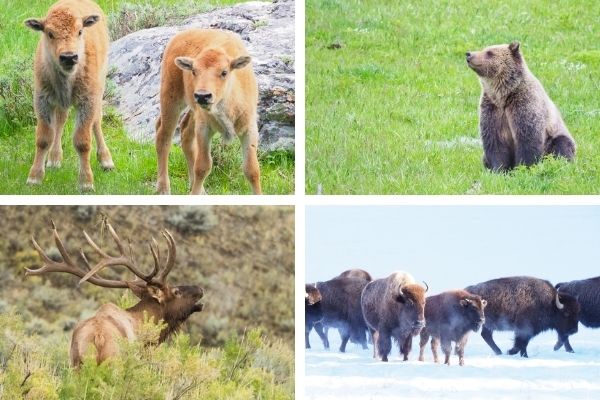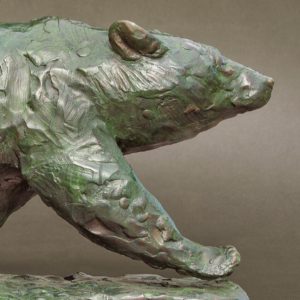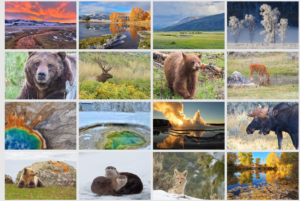Wondering what to pack for your Yellowstone trip?
Each season offers its own special Yellowstone magic. Whichever season catches your fancy or fits your schedule, you’ll want to be prepared with the right clothing and gear to enjoy your adventures comfortably and safely. Our Yellowstone packing lists will help you do just that.
Yellowstone’s high elevation and mountainous terrain can play tricks with the weather. You may experience snow in July, and clear skies can change to ominous storms in the blink of an eye. Always be prepared with warm clothing and a rain jacket, even on warm summer days.
A note about clothing: Generally, wool or synthetic layers are preferred to cotton because cotton loses its insulating value when wet and dries slowly, while wool and many synthetic fabrics retain some warmth when wet and often dry more quickly.
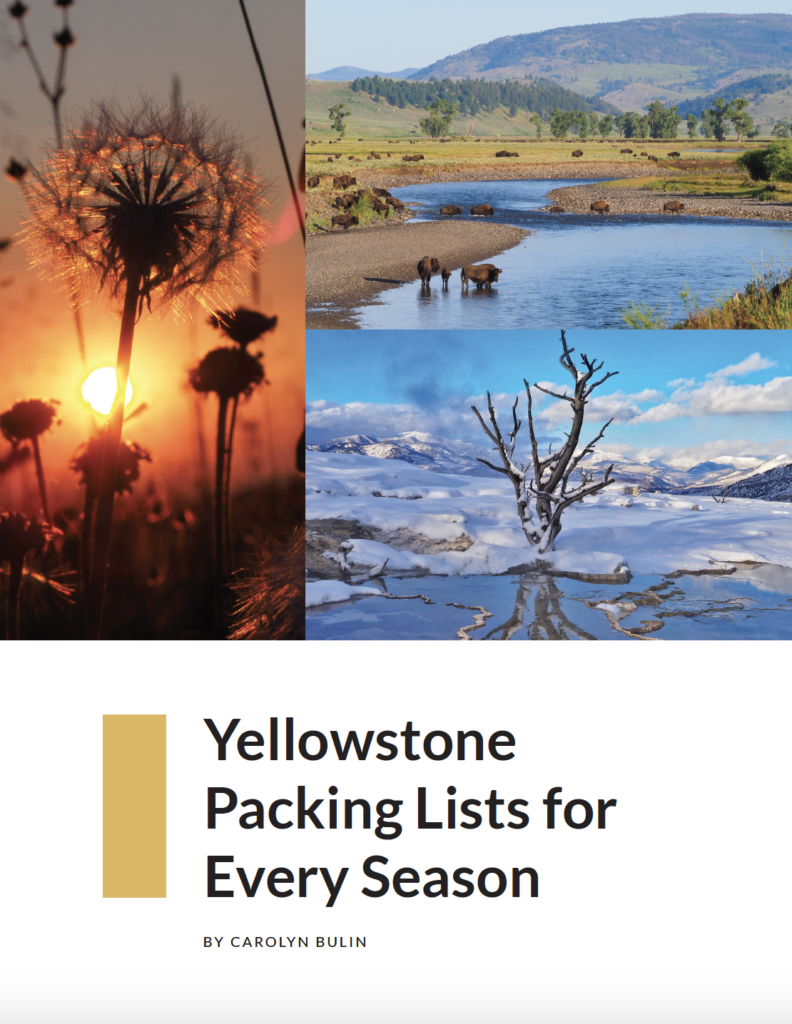
Yellowstone Packing List for Spring
Spring (April – mid-June)
Clothing & Footwear
Yellowstone’s spring weather can range from near-freezing temperatures with rain and snow to above 70 degrees Fahrenheit, so be prepared with a range of clothing layers.
- Insulating base layers (top and bottom): Wool, capilene, or other wicking fabric
- Mid-weight insulating layers (top and bottom): Down, synthetic fleece, or wool
- Waterproof and windproof outer shell (top and bottom): Large enough to fit over all other layers
- Short-sleeved shirts
- Pants: Synthetic hiking pants, leggings, or similar
- Shorts (optional)
- Baseball cap or wide-brimmed hat for sun protection
- Sunglasses
- Warm hat
- Warm gloves
- Socks: Wool or synthetic
- Hiking shoes or boots: Comfortable, sturdy, and waterproof. Consider boots with lightweight insulation for early spring.
- Comfortable footwear for car rides, lounging, etc.
- Stream-crossing shoes or sandals for hikes with stream crossings
- Gaiters: Waterproof to protect from muddy or snowy trails
Gear
- Optics: Binoculars (8-10 power recommended) and spotting scope (rentals available in gateway communities)
- Camera: Anything from a smartphone to professional photography gear is appropriate. If you plan to photograph wildlife, bring lenses with enough power to photograph from a safe, legal, and ethical distance.
- Notebook or journal and supplies (pens, pencils, watercolors, etc.)
- Field guides such as:
- Wildflower guide such as Flora of the Yellowstone (book or app) by Whitney Tilt; Plants of the Rocky Mountains (book) by Linda Kershaw, Andy MacKinnon, and Jim Pojar
- Bird guide such as The Sibley Field Guide to the Birds of Western North America (book) by David Allen Sibley or the Sibley Birds (app)
- Natural history guide such as Rocky Mountain Natural History (book) by Daniel Mathews
- Yellowstone SPOTR (app) for wildlife watching maps
- GeyserTimes (app) for updated geyser info and predictions
- Official Yellowstone National Park app
- GyPSy Guide (app)
- Bear spray and the knowledge to use it (rentals available)
- Water bottles or hydration bladder
- Snacks and lunch
- Sunscreen and lip balm: The sun is more intense at Yellowstone’s higher elevations and sunburns can happen quickly
- Navigation equipment: Maps (such as the National Geographic Trails Illustrated maps), compass, and/or GPS
- First aid kit with basics such as blister treatment (moleskin, athletic tape, blister bandages), bandages, and medications
- Daypack to carry your clothing layers, food, water, etc. on hikes and walks
- Infrared temperature gun (optional) for safely taking temperatures of the thermal features.
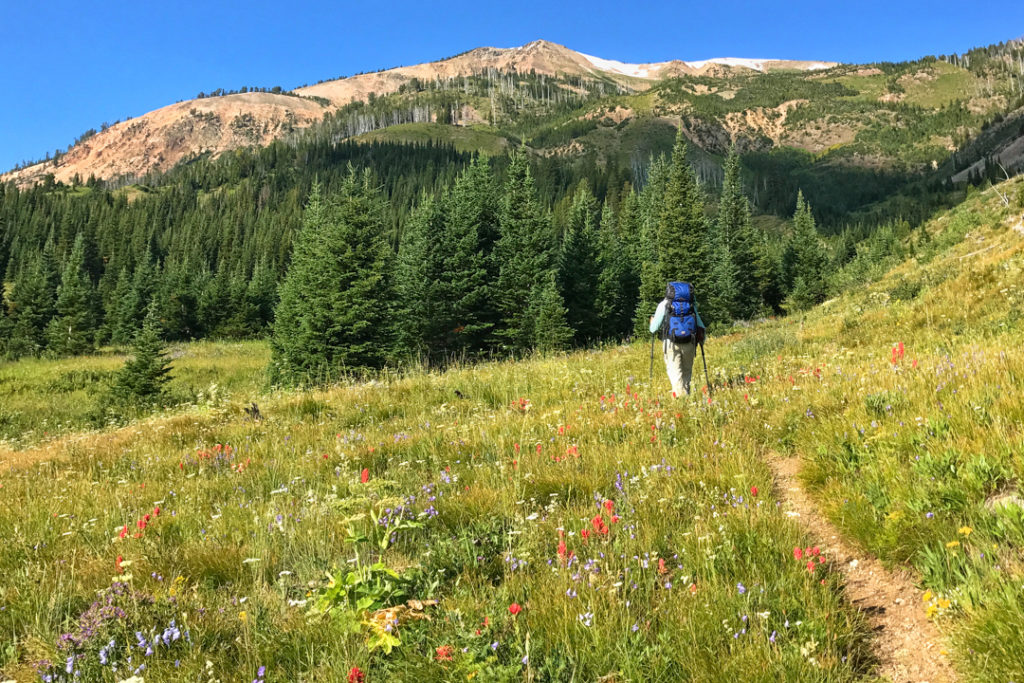
Yellowstone Packing List for Summer
Summer (Mid-June – August)
Clothing & Footwear
Yellowstone’s high elevation means cold temperatures and snowfall can occur at any time of year. Even in summer, warm clothing layers are essential.
- Insulating base layers (top and bottom): Wool, capilene, or other wicking fabric
- Mid-weight insulating layers (top and bottom): Down, synthetic fleece, or wool
- Waterproof and windproof outer shell (top and bottom): Large enough to fit over all other layers
- Short-sleeved shirts
- Long-sleeved shirts: Lightweight, loose-fitting nylon (or similar) shirts for sun protection and insect protection (bug repellent sprays are not effective against biting flies)
- Pants: Synthetic hiking pants or similar; and lightweight, loose-fitting pants for insect protection (bug repellent sprays are not effective against biting flies)
- Shorts
- Baseball cap or wide-brimmed hat for sun protection
- Sunglasses
- Warm hat
- Gloves: Lightweight insulating gloves
- Socks: Wool or synthetic
- Hiking shoes or boots: Comfortable and sturdy
- Comfortable footwear for car rides, lounging, etc.
- Stream-crossing shoes or sandals for hikes with stream crossings
- Gaiters (optional): Lightweight, low-rise gaiters can help keep seeds and other debris out of your hiking shoes
Gear
- Optics: Binoculars (8-10 power recommended) and spotting scope (rentals available in gateway communities)
- Camera: Anything from a smartphone to professional photography gear is appropriate. If you plan to photograph wildlife, bring lenses with enough power to photograph from a safe, legal, and ethical distance.
- Notebook or journal and supplies (pens, pencils, watercolors, etc.)
- Field guides such as:
- Wildflower guide such as Flora of the Yellowstone (book or app) by Whitney Tilt; Plants of the Rocky Mountains (book) by Linda Kershaw, Andy MacKinnon, and Jim Pojar
- Bird guide such as The Sibley Field Guide to the Birds of Western North America (book) by David Allen Sibley or the Sibley Birds (app)
- Butterfly guide such as Butterflies of Grand Teton & Yellowstone National Parks (book) by Steven Poole
- Natural history guide such as Rocky Mountain Natural History (book) by Daniel Mathews
- Yellowstone SPOTR (app) for wildlife watching maps
- GeyserTimes (app) for updated geyser info and predictions
- Official Yellowstone National Park app
- GyPSy Guide (app)
- Bear spray and the knowledge to use it (rentals available)
- Water bottles or hydration bladder
- Snacks and lunch
- Sunscreen and lip balm: The sun is more intense at Yellowstone’s higher elevations and sunburns can happen quickly
- Insect repellent for mosquitoes and biting flies
- Navigation equipment: Maps (such as the National Geographic Trails Illustrated maps), compass, and/or GPS
- First aid kit with basics such as blister treatment (moleskin, athletic tape, blister bandages), bandages, and medications
- Daypack to carry your clothing layers, food, water, etc. on hikes and walks
- Infrared temperature gun (optional) for safely taking temperatures of the thermal features.
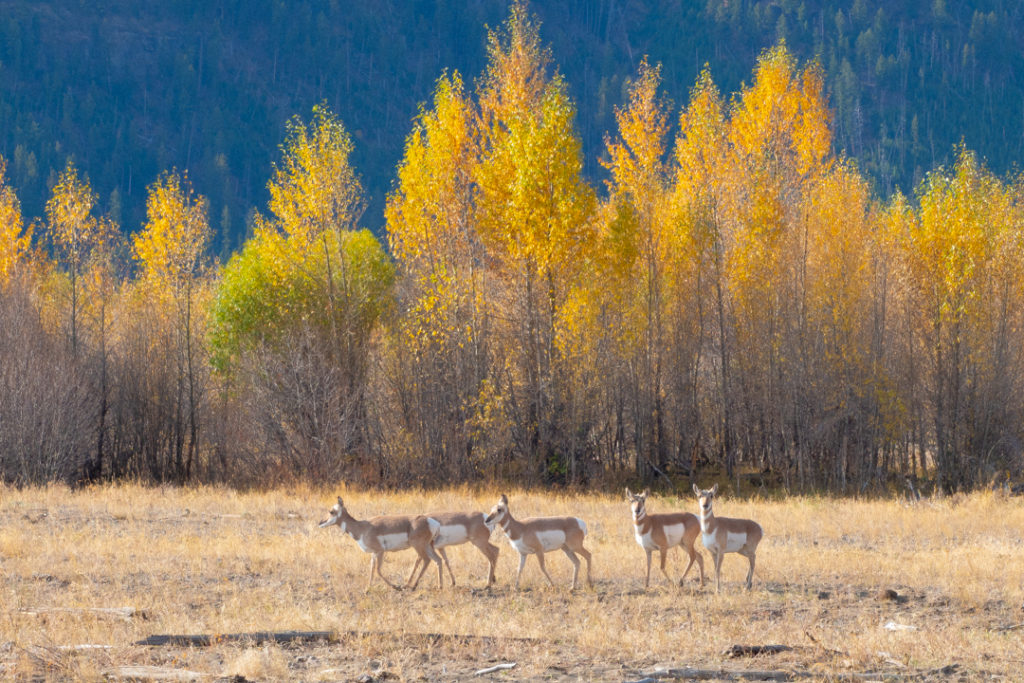
Yellowstone Packing List for Autumn
Autumn (September)
Clothing & Footwear
Yellowstone’s fall weather can range from near-freezing temperatures with rain and snow to above 70 degrees Fahrenheit, so be prepared with a range of clothing layers.
- Insulating base layers (top and bottom): Wool, capilene, or other wicking fabric
- Mid-weight insulating layers (top and bottom): Down, synthetic fleece, or wool
- Waterproof and windproof outer shell (top and bottom): Large enough to fit over all other layers
- Short-sleeved shirts
- Pants: Synthetic hiking pants, leggings, or similar
- Shorts (optional)
- Baseball cap or wide-brimmed hat for sun protection
- Sunglasses
- Warm hat
- Warm gloves
- Socks: Wool or synthetic
- Hiking shoes or boots: Comfortable, sturdy, and waterproof. Consider boots with lightweight insulation for early spring.
- Comfortable footwear for car rides, lounging, etc.
- Stream-crossing shoes or sandals (for hikes with stream crossings)
- Gaiters: Waterproof to protect from muddy or snowy trails
Gear
- Optics: Binoculars (8-10 power recommended) and spotting scope (rentals available in gateway communities)
- Camera: Anything from a smartphone to professional photography gear is appropriate. If you plan to photograph wildlife, bring lenses with enough power to photograph from a safe, legal, and ethical distance.
- Notebook or journal and supplies (pens, pencils, watercolors, etc.)
- Field guides such as:
- Bird guide such as The Sibley Field Guide to the Birds of Western North America (book) by David Allen Sibley or the Sibley Birds (app)
- Natural history guide such as Rocky Mountain Natural History (book) by Daniel Mathews
- Yellowstone SPOTR (app) for wildlife watching maps
- GeyserTimes (app) for updated geyser info and predictions
- Official Yellowstone National Park app
- GyPSy Guide (app)
- Bear spray and the knowledge to use it (rentals available)
- Water bottles or hydration bladder
- Snacks and lunch
- Sunscreen and lip balm: The sun is more intense at Yellowstone’s higher elevations and sunburns can happen quickly
- Navigation equipment: Maps (such as the National Geographic Trails Illustrated maps), compass, and/or GPS.
- First aid kit with basics such as blister treatment (moleskin, athletic tape, blister bandages), bandages, and medications
- Daypack to carry your clothing layers, food, water, etc. on hikes and walks
- Infrared temperature gun (optional) for safely taking temperatures of the thermal features.
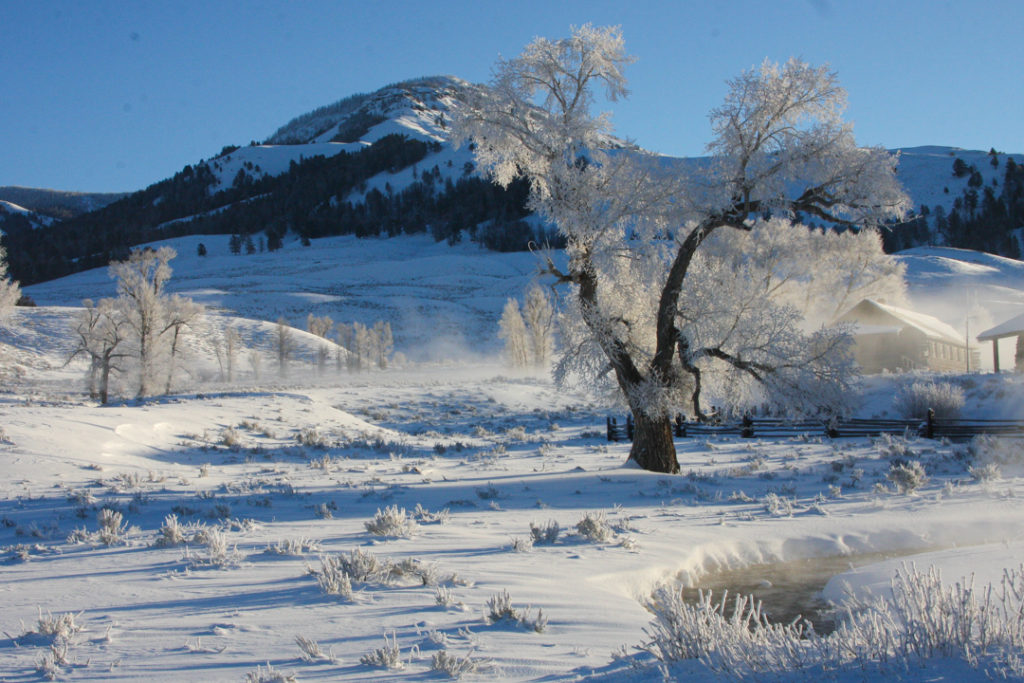
Yellowstone Packing List for Winter
Winter (December – March)
Clothing & Footwear
Temperatures often hover around 0 degrees Fahrenheit but can plummet to -20 or colder or be as warm as 40 degrees Fahrenheit. The use of layered clothing is key to your safety and comfort; be sure your clothing layers work together as a system (e.g., your mid-weight layers should be big enough to fit over your base layers, and your heavy-weight layers should be big enough to fit over your mid-weight layers).
- Insulating base layers (top and bottom): Wool, capilene, or other wicking fabric
- Mid-weight insulating layers (1-3 for top and bottom): Down, synthetic fleece, or wool
- Heavy-weight insulating jacket with hood, such as a down or synthetic-down parka
- Waterproof and windproof outer shell (top and bottom): Large enough to fit over all other layers
- Sunglasses: Sun reflecting off the white snow can cause snow blindness quickly, so sunglasses are essential
- Warm hat that covers your ears: Consider a variety with a bill for sun protection
- Mittens/gloves: Mittens are warmer. Consider two pairs, a lightweight option for warmer afternoons or physical activities such as cross-country skiing or snowshoeing, and a heavy-weight pair for colder mornings.
- Socks: Wool or synthetic. For maximum warmth, layer a thin base-layer pair with a thick insulating pair. Don’t wear more than two pairs of socks at one time, as the tightness of too many socks can restrict blood flow and actually make your feet colder.
- Insulated, waterproof winter boots: For sedentary activities such as wildlife watching, consider a heavily-insulated boot such as Muck or LaCrosse boots, Steger Mukluks, Baffins, or Sorels. For snowshoeing, choose a lighter option such as waterproof, insulated hiking boots.
- Comfortable footwear for evening lounging
- Gaiters to keep snow out of your boots
Gear
- Optics: Binoculars (8-10 power recommended) and spotting scope (rentals available in gateway communities)
- Camera: Anything from a smartphone to professional photography gear is appropriate. If you plan to photograph wildlife, bring lenses with enough power to photograph from a safe, legal, and ethical distance. Consider how you will prevent your camera gear from gathering condensation when moving from cold winter air back into the warmth of a vehicle or building (wrapping cameras and lenses in plastic bags until the gear warms up can be an effective solution).
- Notebook or journal and supplies (pens, pencils, watercolors, etc.)
- Field guides such as:
- Bird guide such as The Sibley Field Guide to the Birds of Western North America (book) by David Allen Sibley or the Sibley Birds (app)
- Natural history guide such as Rocky Mountain Natural History (book) by Daniel Mathews
- Tracking guide such as Scats and Tracks of the Rocky Mountains (book) by James Halfpenny
- Yellowstone SPOTR (app) for wildlife watching maps
- GeyserTimes (app) for updated geyser info and predictions
- Official Yellowstone National Park app
- GyPSy Guide (app)
- Water and a way to prevent your water from freezing (consider insulated water bottles instead of hydration bladders)
- Snacks and lunch
- Thermos for hot beverages
- Sunscreen and lip balm: The sun is more intense at Yellowstone’s higher elevations and sunburns can happen quickly, especially in winter when the sun reflects off white snow.
- Navigation equipment: Maps (such as the National Geographic Trails Illustrated maps), compass, and/or GPS
- First aid kit with basics such as blister treatment (moleskin, athletic tape, blister bandages), bandages, and medications.
- Daypack to carry your clothing layers, food, water, etc. on hikes and walks
- Hand and Toe/Foot Warmers
- Infrared temperature gun (optional) for safely taking temperatures of the thermal features.
- Snowshoes (optional, rentals available)
- Cross-country skis, boots, poles, wax (optional, rentals available). Yellowstone has a variety of groomed and ungroomed trails [link to Jenny’s “best skis” post], so for all-around use choose a backcountry model that is thin enough to fit in standard groomed tracks and has metal edges.
Need help planning your trip? Book a Yellowstone Trip Planning session with our favorite guide partners.
Carolyn Bulin has been sharing her passion for the Greater Yellowstone Ecosystem for over a decade. As a naturalist and certified trainer of interpretive guides, she enjoys leading field classes and teaching others the art and science of guiding. When not teaching or writing, she can be found exploring the park with her husband and daughter.
Photos © Jenny Golding

